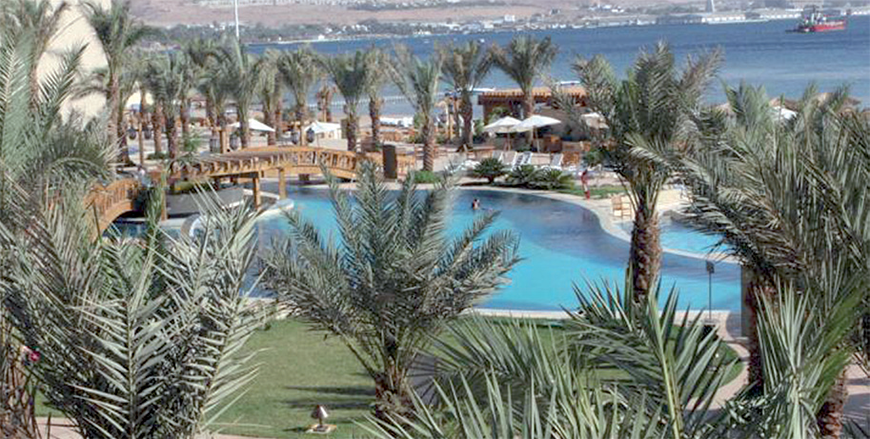You are here
Amman hotel room revenue rate 2nd lowest in region — report
By Dana Al Emam - Apr 18,2017 - Last updated at Apr 18,2017
AMMAN — The direct relationship between hotel occupancy rates and the revenues of the hotel industry requires a better addressing of the market's needs, experts agreed on Monday.
Promoting tourism in Jordan in markets that are not easily affected by regional unrest, creating better matching between investments and touristic patterns and addressing "high" operational costs can increase occupancy rates in hotels, which will boost revenues, they agreed.
A recently report published by Ernst & Young showed that the average occupancy rate of hotels in Amman was around 44 per cent, while the revenue per average room (RevPAR) stood at $65 (JD46.12).
The only city with a revenue rate lower than Amman was Cairo, registering a RevPAR of $53 (some JD37.6), according to the February 2017 MENA Hotel Benchmark Survey Report.
Meanwhile, the highest RevPAR rates in the region were registered in Dubai ($253/JD179.5), Muscat ($147/JD104.3), Doha ($138/JD97.9), Abu Dhabi ($136/JD96.5) and Jeddah ($133/JD94.3).
Regarding occupancy rates, Amman only topped Mecca (39.4 per cent), while the highest hotel occupancy rates were in Dubai (88.2 per cent), Muscat (87 per cent) and Abu Dhabi (83.4 per cent), followed by Ras Al Khaimah (73.9 per cent) and Doha (72.8 per cent).
Commenting on the report's findings, Jordan Hotels Association (JHA) President Michael Nazzal said the managements of hotels in Amman find themselves obliged to reduce room prices in order to enhance competitiveness among dropping occupancy rates.
Nazzal noted that tour operators, who have been seeing lower numbers of tourists, are requesting lower room prices from hotels in order to keep their share of revenues.
The sector leader cited two problems that must be addressed in order to increase occupancy rates in hotels.
Firstly, he argued, Jordan's promotion as a touristic destination must be more efficient in markets that are relatively immune to news of unrest in the region, such as the Gulf region, Jordanian expatriates and the Far East.
Another issue to be addressed is that the majority of Jordan's visitors demand three and four-star hotels, while there is an abundance of five-star hotel rooms.
Furthermore, around 1,000 to 1,500 new five-star hotel rooms will start operating in newly built hotels.
Yasar Majali, country manager of Sabre, a world travel network that offers high-tech solutions, agreed with Nazzal on the need to tap new opportunities in the Far East, including China and India, where the percentage of wealthy people who are willing to travel for leisure is high compared to the large populations.
Meanwhile, Majali, who is a former JHA executive director, attributed the drop in occupancy rates to the political conditions in the region, noting that increases in the number of visitors also boosts the work of tour guides, tourist transportation and souvenirs shops.
Jordan Inbound Tour Operators Association Vice Chaiman Awni Kawar cited a "direct correlation" between occupancy rates and the revenues per average room, adding that an increase in demand raises the prices of hotel rooms.
Meanwhile, he described the RevPAR of $65 cited in the report as a "low" rate, adding that the rate must be at least 50 per cent in order to be feasible.
Although electricity tariffs for the sector were recently reduced by half, Kawar, who is also an investor, explained that hotels in Amman are subject to a 16 per cent sales tax and a 10 per cent service charge, in addition to "high" water tariffs and land ownership fees.
These factors increase operational costs for hotels, which do not allow them to offer rooms at very low prices in a bid to enhance occupancy rates.
Related Articles
The hospitality sector in Jordan faced a difficult year in 2013 because the number of tourists dropped, according to Jordan Hotel Association (JHA) Chairman Michael Nazzal.
AMMAN — Hotel occupancy rates of all categories this weekend reached 69 per cent in Amman, 52 per cent in the Dead Sea, 55 per cent in Aqaba
AMMAN — As Eid Adha is around the corner, tourism sector representatives affirm that the long holiday will bring a boost to local tourism bu













